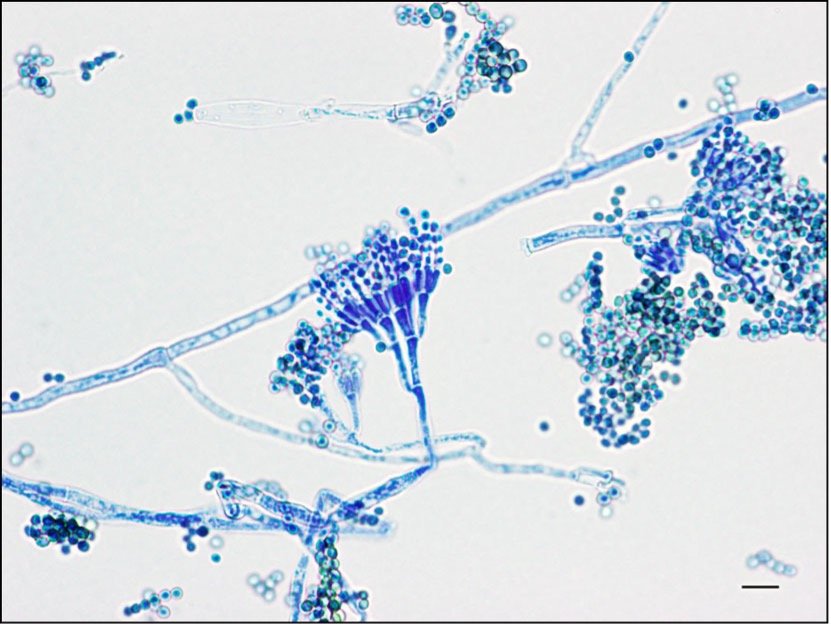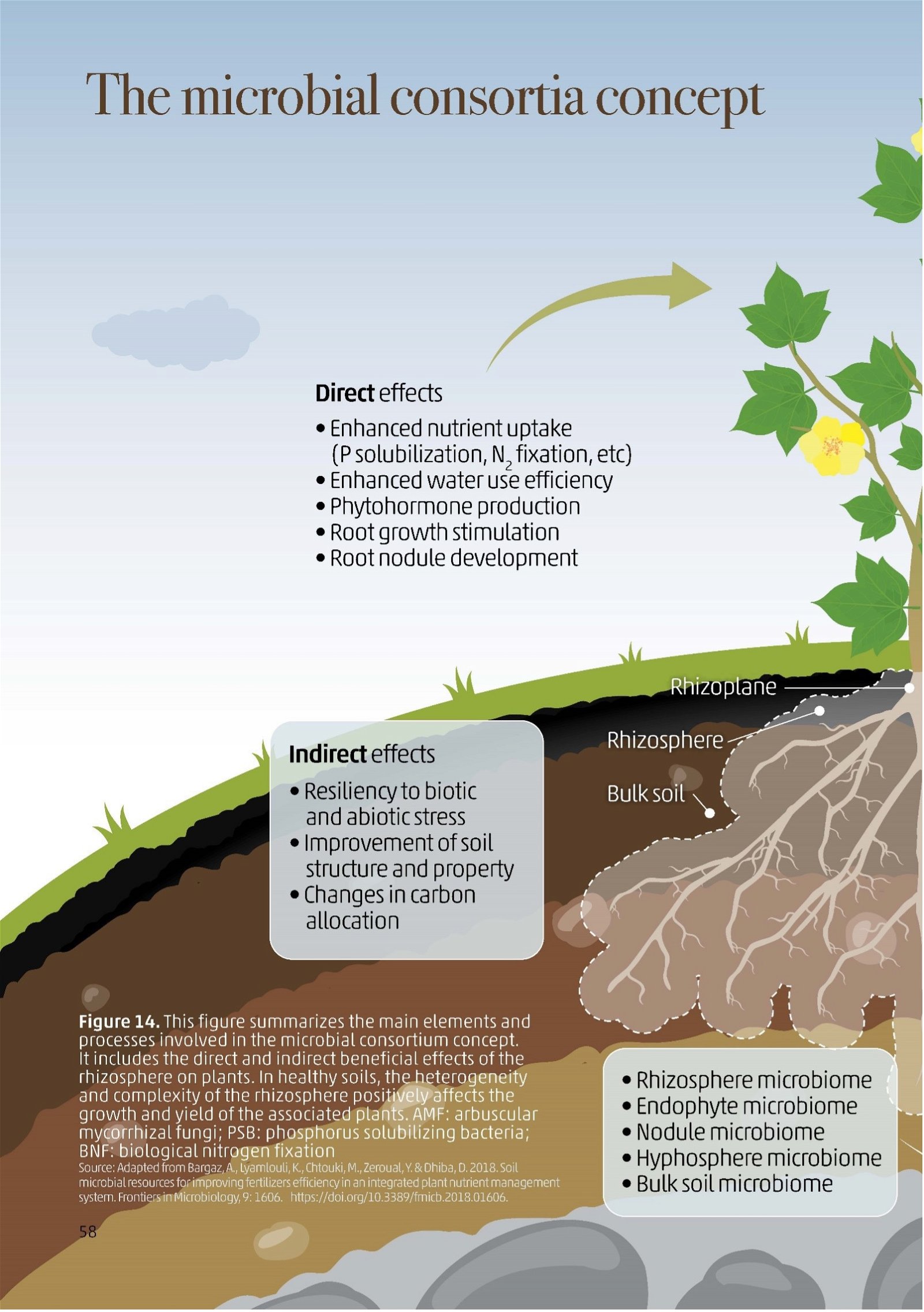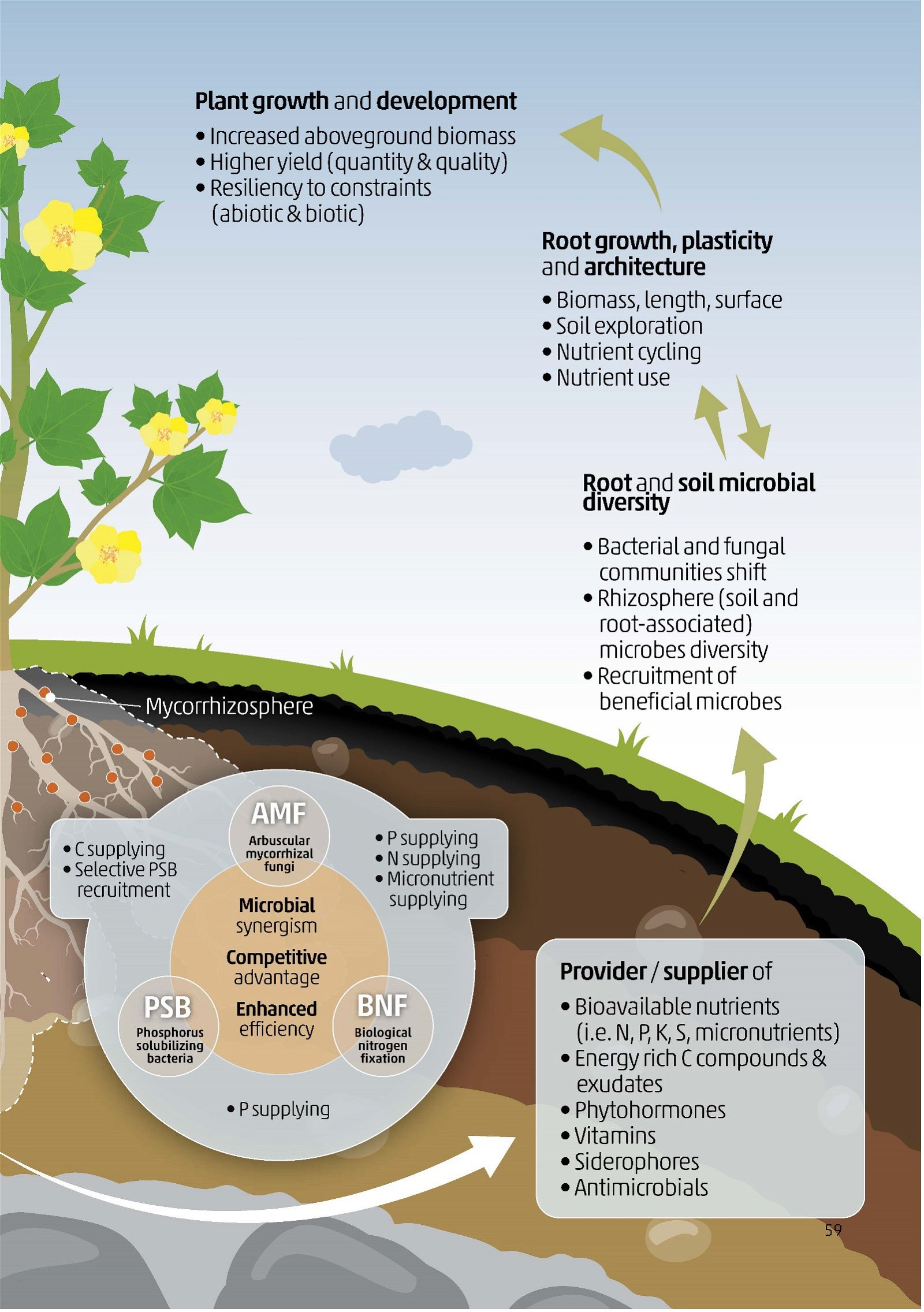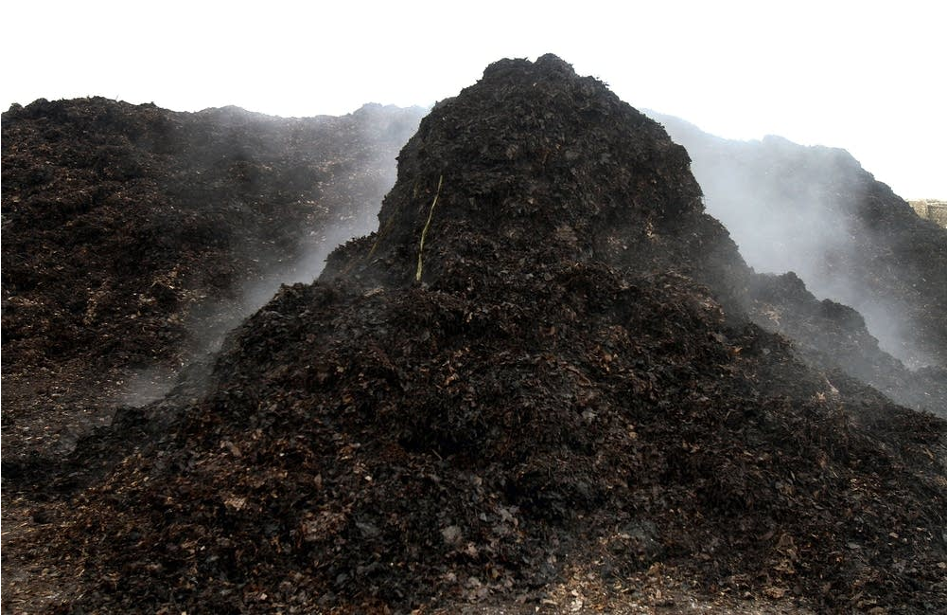Circular agriculture: the soil microbiome and the advantage of using recycled nutrient


· 6 min read
The combination of the use of beneficial and environmentally friendly microorganisms for agricultural production, such as P (phosphorus) solubilizers and N (nitrogen) fixers, together with inorganic fertilizers, is an increasingly important line of research aimed at developing microbial formulations that enhance the benefits of mineral inputs reducing harmful effects on the environment. Since most agricultural systems are N- and P-limited, this novel approach will likely be of global interest. - FAO, 2022
Soil microorganisms constitute the predominant component of soil biomass, with a remarkable abundance ranging from 10 million to a billion bacteria inhabiting a mere gram of soil. Nonetheless, many of these microorganisms remain enigmatic, as they defy cultivation on standard laboratory culture media.
The term "microbes" encompasses a spectrum of microorganisms, including bacteria, fungi, enzymes, and more, along with their genetic material and the intricate web of interactions they establish within the soil matrix. It is imperative to emphasize the significance of conserving soil biodiversity as a foundational prerequisite for preserving the soil microbiome. This conservation effort, in turn, underpins the essential equilibrium of the entire ecosystem.
Substantiated evidence unequivocally demonstrates that even a solitary polymicrobial inoculation can engender favorable consequences for agricultural productivity (Bargaz, Lyamlouli, et al., 2018).
Acknowledging the profound significance of soil microbial biodiversity for both plant life and humanity, the next imperative step is to harness this invaluable resource to enhance crop production, elevate human well-being, and concurrently foster environmental sustainability—paving the way for a promising agricultural future.
Figure 1. Penicillium bilaiae, used in agriculture, works against soil salinity and to mobilize P



Recycled nutrients, as defined by the Food and Agriculture Organization (FAO, 2019c), encompass plant nutrients that are initially applied to and absorbed by growing plants but can subsequently be reintegrated into the nutrient cycle. Source of these nutrients are materials that come from various sources, including wastewater, algae biomass, aquatic plants, sewage sludge, biosolids, animal manure, urban wastes, composts, vermicompost, biochar, inorganic or organic byproducts such as struvite, ammonium sulfate, and residues from food, agroindustry and on. The reintegration can occur through various means, including their use as byproducts of food processing, their presence in plant residues returned to the soil, or their incorporation into the human or animal food chain.
The overarching goal is to promote circular economy objectives by closing the life cycles of fertilizer products and minimizing waste.
Figure 2. Compost of animal and vegetal waste, treated with decomposing microbes

Using recycled nutrients holds great potential for enhancing plant growth and yield. Studies indicate that the performance of crops nourished by recycled nutrients can be on par with, or even surpass, that of conventionally applied fertilizers. However, it is imperative to exercise caution in their application to ensure environmental sustainability. This entails meticulously eliminating undesirable contaminants, such as heavy metals, from recycled nutrient sources (Saliu & Oladoja, 2021).
An essential facet of responsible resource utilization is recycling edible food materials. This approach aligns with social responsibility objectives and directly impacts the availability of feedstock for utilization processes. Economically driven motivations are expected to stimulate the processing of more edible food fractions, possibly through biorefineries, to yield high-value products. On the other hand, the inedible fraction of food waste can be efficiently directed toward recycling processes, where it can be effectively transformed into new products (Pleissner, 2018).
Compost of animal and vegetal waste, treated with decomposing microbes
The transition towards a circular nutrient economy necessitates formulating and implementing policy measures that encourage the production and utilization of composts and digestates. These policies should aim to minimize inefficient nutrient use, stimulate demand for recycled fertilizers, and provide logistical support for biomass processing. In the interim period before markets for recovered resources are fully established, public and private investments, technological advancements, and institutional adaptations are pivotal in creating conditions conducive to the profitable and safe production and consumption of recycled nutrients (Valve, Ekholm, & Luostarinen, 2020).
This concerted effort towards sustainable nutrient management and circular economy principles holds promise for addressing contemporary agricultural and environmental challenges while promoting responsible resource utilization.
Indeed, the utilization of microbial treatments, including probiotic products for plants and enzymes, represents a significant agro trend with the potential to reduce our reliance on chemical fertilizers and enhance circular agriculture and sustainability. This emerging field capitalizes on the multifaceted capabilities of underground biodiversity to revolutionize how we do agriculture. Introducing microbial populations with the capacity to facilitate nutrient recycling and stimulate plant growth promises to boost soil fertility and augment crop resilience against both biotic and abiotic stresses.
One of the key players in this arena is the concept of" Multifunctional microbial consortia." These consortia consist of Plant Growth-Promoting Microbes (PGPMs) with diverse functions, encompassing bio-waste decomposers, nitrogen-fixing bacteria, phosphorus-solubilizing microorganisms, and antagonists against phytopathogens.
Such microbial communities play a pivotal role in elevating agricultural productivity and bolstering the sustainability of food supply chains: they offer the potential to create new, sustainable, high-quality food products.
By leveraging the synergistic interactions between these PGPMs and bio-effectors, agriculture benefits from improved soil health, optimized circular nutrient utilization, and enhanced crop performance. Moreover, this approach aligns with the broader goals of sustainable agriculture by minimizing the environmental footprint associated with agricultural inputs such as chemical fertilizers and pesticides.
In summary, adopting microbial treatments is a critical factor for both plant life and humanity because underground biodiversity heralds a promising future for circular, sustainable, and quality agricultural outputs.
By harnessing the potential of multifunctional microbial consortia, we can work towards ensuring our food supply chains' resilience and long-term viability while reducing the environmental impact of conventional agricultural practices.
illuminem Voices is a democratic space presenting the thoughts and opinions of leading Sustainability & Energy writers, their opinions do not necessarily represent those of illuminem.
Bargaz, A., Lyamlouli, K., Chtouki, M., Zeroual, Y. & Dhiba, D. 2018. Soil microbial resources for improving fertilizers efficiency in an integrated plant nutrient management system. Frontiers in Microbiology, 9: 1606. https://doi.org/10.3389/fmicb.2018.01606
Saliu, T.D. & Oladoja, N.A. 2021. Nutrient recovery from wastewater and reuse in agriculture: a review. Environmental Chemistry Letters, 19(3): 2299–2316. https://doi.org/10.1007/s10311-020-01159-7
Pleissner, D. 2018. Recycling and reuse of food waste. Current opinion in green and sustainable chemistry, 13: 39–43. https://doi.org/10.1016/j.cogsc.2018.03.014
Valve, H., Ekholm, P. & Luostarinen, S. 2020. The circular nutrient economy: needs and potentials of nutrient recycling. Chapters, pp. 358–368. Edward Elgar Publishing. https://ideas.repec.org/h/elg/eechap/18519_27.html
Contents from FAO, 2022. Soils for nutrition: state of the art. Rome. https://doi.org/10.4060/cc0900en
illuminem briefings

Agriculture · Public Governance
Michael Wright

Agriculture · Environmental Sustainability
Yury Erofeev

Food · Agriculture
Politico

Climate Change · Agriculture
The Guardian

Climate Change · Agriculture
The Guardian

Agriculture · Climate Change